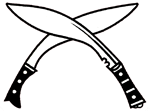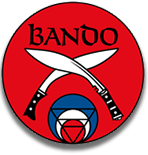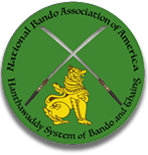 The Bando emblem is the symbol of the Bando discipline, or system of martial arts. The emblem itself is comprised of three basic elements; two crossed swords, three circles and three triangles. Each portion of this emblem symbolizes various vital segments of the history, philosophy and principles of the Bando discipline.
The Bando emblem is the symbol of the Bando discipline, or system of martial arts. The emblem itself is comprised of three basic elements; two crossed swords, three circles and three triangles. Each portion of this emblem symbolizes various vital segments of the history, philosophy and principles of the Bando discipline.
The Emblem as Part of the Bando Uniform
The Bando emblem became an important part of the uniform for the Bando discipline. The emblem, or patch as it is commonly referred to for the purpose of the uniform, is given to a student only after the student has proven himself worthy. There is no set timeframe, and the criteria vary slightly from instructor to instructor, but the general guidelines are:
- Dedication to the instructor, the class and the system
- Effort put forth in training, both in and out of class
- Understanding of the basics of Bando
- Understanding of the Bando system
The “student” patch is worn on the student’s uniform until such time as they achieve their first-level black belt. At that time the “student” patch is replaced with the “black belt” or “blood” patch. The difference between the “student” and the “blood” patch is in the color. The “student” patch is devoid of color. The student is an empty vessel in which the instructor plants the seed of knowledge. With proper care and nurturing that seed will grow and blossom into a black belt, someone who has now earned the right to learn the Bando discipline.
The Crossed Swords – a glimpse into Bando’s History
 The crossed swords in the Bando emblem are symbolic of the merging of the martial arts of the East and West for the purpose of mutual friendship, understanding, and exchange of ideas. Many scholars believe that the particular type of short sword seen crossed at the left in the symbol is a Kopis. This was considered the typical blade carried by the armies of Alexander the Great as they invaded India. History shows that this sword was copied by the Indians and evolved into what is known today as the Kukri – the weapon that is so often considered symbolic of the great Gurkha warriors.
The crossed swords in the Bando emblem are symbolic of the merging of the martial arts of the East and West for the purpose of mutual friendship, understanding, and exchange of ideas. Many scholars believe that the particular type of short sword seen crossed at the left in the symbol is a Kopis. This was considered the typical blade carried by the armies of Alexander the Great as they invaded India. History shows that this sword was copied by the Indians and evolved into what is known today as the Kukri – the weapon that is so often considered symbolic of the great Gurkha warriors.
The kukri is a dominant symbol in the badges of all Gurkha regiments and units; it was also featured in the World War II shoulder flash of the 43rd Gurkha Lorried Infantry Brigade. After the war the kukri also appeared in the formation insignias for many Gurkha formations including the 18th Brigade, 48th Brigade, 51st Brigade, 63rd Brigade, 99th Brigade, and the Gurkha Far East Field Force and 28th Squadron Gurkha Transport Regiment of the Gulf War.
It was the crossed kukri insignia of the 10th Burma Gurkha Rifles that inspired the original members of the Military Athletic Club and later the National Bando Association to adopt the crossed swords as a symbol of the Bando Discipline in 1947.
Color Representation
 The “blood” patch is filled with three colors, each representing different qualities expected of a black belt in the Bando discipline.
The “blood” patch is filled with three colors, each representing different qualities expected of a black belt in the Bando discipline.
- Red: The color filling the smallest of the three circles within the emblem is symbolic of courage and bravery.
- White: The color filling the second largest of the circles within the emblem is symbolic of purity, honor, and nobility.
- Blue: The blue color filling the largest of the circles within the emblem is symbolic of calmness, reason and insight
The symbolism associated with the three circles will be more meaningful during the discussion of the circles themselves.
Circles and Triangles – The Philosophy of Bando
The circles and triangles in the Bando emblem are far more than just decorative. These symbols have meaning and depict both the philosophy and principles of the Bando discipline. Bando takes a very holistic approach to understanding the world around it. Bando also takes that same holistic approach in its teaching philosophy. Students of the system are encouraged to develop a love for the philosophy and psychology of man, and to strive for patience and harmony within themselves.
The three circles and the three triangles together in the emblem represent Man.
The three circles represent the worlds of man, while the three triangles represent the elements that affect each of those worlds. The worlds depicted in the Bando emblem are:
- The world of self
- The world of human association
- The world of the universe
It is in the smallest circle, the world of self, that it is believed man has the most control. Within this circle are the three elements that most affect the world of self; the upper left corner represents body, the upper right corner represents mind and the bottom corner represents spirit. Is is these elements that man has the most direct control on, and it is also these elements which, in combination, constitute life. The red color of this circle in the “blood” patch depicts that through proper control and alignment of the mind, body, and spirit, man can achieve courage and bravery.
The next circle, the middle circle, represents the world of human association. To bring into company or relationship, to combine together, to unite oneself with another or others as in friendship; to connect mentally; to join or be in company or relation with; to unite, as in nations. The world of human association refers to the human race, and how the Bando practitioner relates to those around them. If we look back to the significance of the white color for this circle in the “blood” patch we see it stands for purity, honor and nobility. These are the qualities most admired of an individual in society – someone who’s thoughts and actions benefit rather than diminish those around them.
The elements that most affect the world of human association are birth, at the top left of the triangle, life at the top right of the triangle and death at the bottom. At their base it can be said that birth, life and death are the only true common elements amongst all humans. And a psychological perspective might point out that from the moment a man is born he embarks on a journey to define himself within his world. What he does and how he associates with others through his life will ultimately determine how he is remembered after his death.
The final circle, the large outer circle, represents the world of the universe. The elements acting on this world, as represented by the large outer most triangle, are earth at the top left, air at the top right, and water at the bottom. From earth, air, and water come all things needed to sustain life.
The intersections of the circles and triangles also have great importance. The point at which the circles and triangles meet is called the point of harmony. Although these worlds, and the elements that act on them, overlap to some degree it is important to notice that the three worlds are linked by the elements of water, death and spirit. It is believed that only through these three elements may the three worlds harmoniously blend.
Conclusion
Along the path of self-discipline necessary for progress toward perfection in the Bando discipline, one will learn about the three elements of self – the Body, the Mind and the Spirit. The ultimate goal is to develop perfect harmony of these elements. The first step to self discipline (and self-defense) is controlling one’s inner emotion, one’s behavior etc. The key is to learn, train, develop, and refine the Body, Mind and Spirit. As one is able to adapt to these principles, the progress in the martial arts as well as in life in general, will be astounding.
In order to fully embrace the philosophy of Bando, one must also come to the realization that there is no “One True Way.” There are many paths leading to the truth.


